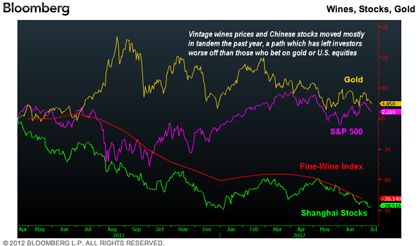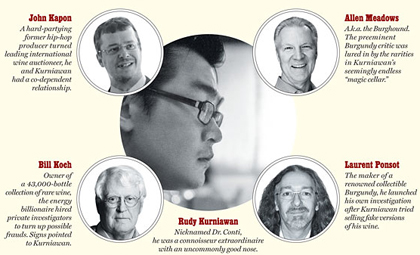Dr Vino's wine blog
wine talk that goes down easy
Kurniawan house photos
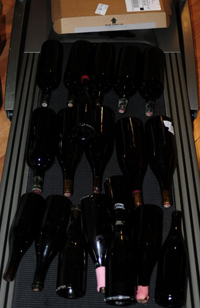 The Justice Department filed some photos in their wine counterfeiting case against Rudy Kurniawan. Don Cornwell, a collector and attorney who has been actively following the goings-on, posts the six pictures that the government filed in their latest brief to rebuff Kurniawan’s claim that they entered his house illegally.
The Justice Department filed some photos in their wine counterfeiting case against Rudy Kurniawan. Don Cornwell, a collector and attorney who has been actively following the goings-on, posts the six pictures that the government filed in their latest brief to rebuff Kurniawan’s claim that they entered his house illegally.
While the stacks of boxes, packed and ready to go in the front hall is pretty damning (would love to know where they were headed), there’s got to be a metaphor in the 17 unlabeled bottles lying on the treadmill. They just keep going around and around…
Invest in China, not wine (chart of the day)
The S&P 500 and gold have outperformed fine wine as an investment over the past few months. But the correlation is most notable between wine and the Shanghai composite as the above chart and article from Bloomberg shows. Since the April 18, 2011 high in Shanghai, wine and Chinese stocks have moved down in tandem, a glaring correlation.
This gives further evidence to our previous question of whether the specter of fraud is casting a pall on the fine wine market: it seems China is such a big driver of fine wine prices, that fraud (specifically, the apprehension of Rudy Kurniawan) has little effect.
So…why not stop treating wine like an asset class, actually pull a few corks, and trade the Shanghai composite instead if you want similar returns to wine? (Or, US stocks or gold for the best return, in hindsight.)
Details from a sealed deposition
Don Cornwell, an attorney and wine collector, posted an admonition earlier this year not to bid on wines he considered fake wines form Rudy Kurniawan. That spawned an enormous and on-going comment thread over on wineberskers about wine counterfeiting. The thread has heated up in the last week or so Don is back with some new details.
A key part of Kurniawan’s undoing may have been bidding on a ’47 Ponsot Clos St. Denis that he thought was from Domaine Ponsot but was actually from the unrelated Christine Ponsot. Cornwell posts the actual listing in the 2004 Acker, Merrall Catalogue, showing it simply as “Ponsot,” adding, “it makes you wonder if [auctioneer] John Kapon ever really looked at the bottle in question.” Cornwell points out that Kurniawan engaged in a bidding war with another collector, who also may have thought it was a Domaine Ponsot bottling.
Then Cornwell publishes excerpts from sealed depositions, now public, from Bill Koch’s suit against Eric Greenberg. It’s confusing but Greenberg got into wine in a big way, quickly amassing a wine collection of over 60,000 bottles. And then just a few years later, for “health-related reasons,” he whittled the cellar down to a mere 20,000 – 30,000 bottles. In his acquisition spree, he apparently picked up some dodgy bottles from Hardy Rodenstock (see extensive backgrounder). And Koch bought some of those at auction, which was the basis for his suing Greenberg (Koch had previously won a default judgment against Rodenstock; the suit against Greenberg is still pending).
A couple of remarks stand out from the sealed court proceedings: one witness testified that “[Greenberg] said if he had counterfeit wine, he could always sell it through Acker Merrall because John Kapon would take anything.” Also, there was a death threat!
There, now you have your dose of wine counterfeiting news for the week. And more fodder for your screenplay.
The wine fraud story in Vanity Fair
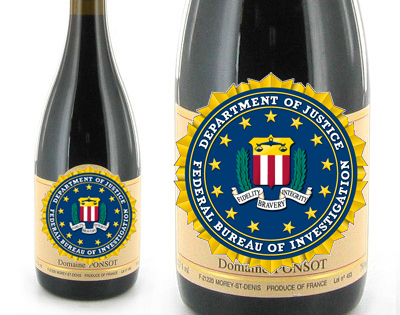
Mike Steinberger writes a nuanced, 5,000-word piece on Rudy Kurniawan and wine counterfeiting on VanityFair.com. Although it draws some material we have discussed here previous, such as the court documents including Kurniawan’s indictment on wine and mail fraud, the piece offers insights from numerous interviews of participants involved in the multi-million dollar saga. Lots of interesting details emerge: apparently Kurniawan purchased so much “unremarkable” old Burgundy from one negociant that he “emptied [their] cellars.” Also, the complexity of Burgundy may have been what tripped him up as early in his rise in the wine world, Kurniawan appears to have confused a Christine Ponsot Clos Saint-Denis for a Domaine Ponsot (unrelated) Clos Saint-Denis that didn’t even exist. Steinberger writes “If that is what happened, it is a mistake that now has Kurniawan facing up to 80 years in a federal penitentiary.”
If you are going to looking for a long, thorough piece on the wine fraud story, check out this terrific one. What part of the story do you find the most amazing?
“A Vintage Crime” VanityFair.com
Is the fog of fraud dampening fine wine prices?
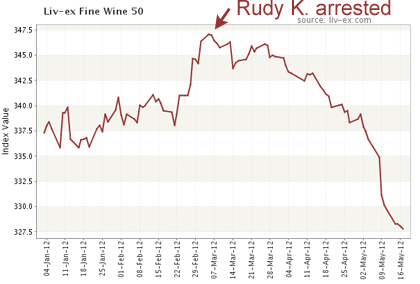
The arrest of Rudy Kurniawan on March 8 coincided with the top in the fine wine market this year.
Even though Kurniawan–whose guilt or innocence on wine counterfeiting charges remains to be tried in federal court–was apprehended, wine fraud remains an easy crime: combine sky-high prices with an old collectible whose authenticity may be difficult to verify and willing buyers who may have more capital than wine know-how or may have little intention of ever opening the bottles anyway.
Wine counterfeiting has been around for decades and I’ve always been surprised that it doesn’t get priced in to the fine wine market (but wines sold directly from the producers do fetch a premium). Paul Chiu, a Burgundy fan in Hong Kong, tweeted to me the other day that there’s still surprisingly little discussion about counterfeiting there.
So, as the ArtInfo points out, the decline in the (young) Bordeaux index probably has more to do with shifting (more discriminating?) tastes to old wine and Burgundy since the broader Liv-Ex 100 has not fallen as sharply. “Lafite is out, and Conti is in.” Ack, if the auction market’s taste for Burgundy shifts into high gear, it could crush even a non-collector’s premier cru habit.
But with the Chinese economy slowing down, FT Alphaville suggests some cynics might point out that fewer wines are needed for bribes. Baksheesh aside, it will be interesting to see if, going forward, counterfeiting or the Chinese economic slowdown impacts fine wine prices more. But maybe there will be more buyers, such as the Stamford Management Group, which is raising $100 million for a fund to buy Bordeaux and jade antiques. And perhaps there will be more liquidity and lower spreads if SecondMarket really gets into wine.
NY mag on the Rudy K saga
New York magazine has a lengthy piece by Benjamin Wallace (author of The Billionaire’s Vinegar) on counterfeiting wine and the saga of Rudy Kurniawan. Grab a magnum of coffee and check it out.
Rudy Kurniawan, aka “Dr. Conti” indicted on four counts
Rudy Kurniawan, aka “Dr. Conti” aka “Mr. 47,” was indicted on four counts of counterfeiting, mail fraud and wire fraud in federal court yesterday. Mike Steinberger posted the 25-page indictment signed by US Attorney Preet Bharara to his blog.
The indictment largely covers the same ground as the documents filed when Kurniawan was apprehended in his home in L.A. in March. It fails to name the auction house where Kurniawan was the consignor of wines in 2008 where Laurent Ponsot dramatically stopped the sale in the room even though it has been widely reported. Nor does it mention the London auction house where he allegedly sold fraudulent bottles through a front man even though it was widely discussed. The front man’s identity at that auction is not revealed; the New York City restaurant that shipped empty bottles to his home remains anonymous and several collectors are mentioned but not named. Further, the “relatively recent” California wines that were to indicated to pass off as older Bordeaux and Burgundy have not been named. So there are still some gaps to the story. But details will emerge as the legal proceedings continue; also, two articles in major, non-wine magazines are in the works.
The case is U.S. v. Kurniawan, 12-MAG-606, U.S. District Court, Southern District of New York.
The etiquette of pouring a counterfeit wine
Mike Steinberger, friend of the blog, started a series of posts on his blog wherein he plays Wine Ethicist, answering (or posing) questions on etiquette in the wine world. Since Mike has fallen off the face of the internet (actually, I think he’s traveling) and has let his blog idle this week, we’re happy to pick up the slack on etiquette with a timely topic: the serving of counterfeit wine.
The arrest of Rudy Kurniawan was all the buzz everywhere I went this week (well, except my local grocery store, where nobody cared). As the talk led to counterfeiting, many in the wine world shared stories with me of dodgy or legendary bottles they’d had, the suspicious people they’d met, or why, like those at my grocery store, they couldn’t give a rip. I largely agree with that last point: while the tale of bling, duplicity and gullibility has undeniably enticing details and wine is deliciously multifacted, I spend my professional life tasting wine and writing about principally because I like to drink it with dinner. I’m not interested in chasing down magnums of ’47 Lafleur; I’ll stick with Lapierre Morgon because it’s not only more affordable but there’s there no chance of it being fake.
One sommelier told me this week that he opened a bottle that a collector had brought in. Although it had a celebrated 1947 Bordeaux was written on the label, when he pulled the cork, it read 1966 Rioja. So, here’s the etiquette question/ethical quandary: should the somm have alerted the diner to the fake right away or let the him and his companions enjoy the wine as if it were what was on the label?
Hit the comments with your thoughts. And I’ll share what the somm did after you’ve had a chance to weigh in.
